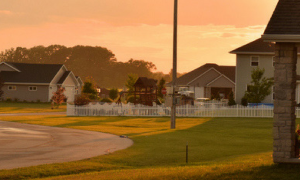By Ryan Hanley
Ready to buy your first home? Before you dot the I’s and cross the T’s on your mortgage, it is important to understand the ins and outs of homeowners insurance.
Without homeowners insurance, a property buyer is unlikely to secure a house. Homeowners insurance protects a residence—and the items stored in a residence—against disasters. Therefore, if your home is suddenly destroyed in a hurricane, tornado or other natural disaster, homeowners insurance guarantees you are fully protected.
Homeowners insurance should be simple, but there are many factors to consider as you evaluate all of the coverage options at your disposal.
Now, let’s take a look at five common questions about homeowners insurance.
- Why Do I Need It?
There are two reasons why homebuyers must purchase homeowners insurance:
- It enables you to protect your assets. Homeowners insurance safeguards the structure of your home and your personal property. It also protects you against liability for injuries to others or their property while they are on your property.
- Your mortgage lender probably requires you to have it. Most lenders will require you to maintain homeowners insurance for the duration of your mortgage. A lender usually will require you to list the company as a mortgagee on your homeowners policy. Moreover, if you let your homeowners coverage lapse, your mortgage lender likely will have your home insured at a much higher premium and with less coverage that what you had in the past.
Homeowners insurance is a must-have for homeowners, without exception. If you allocate the time and resources to find the right homeowners coverage, you should have no trouble protecting your house and personal belongings for years to come.
- How Does It Work?
Generally, homeowners insurance is considered a “package” policy because it includes a combination of coverages. The package policy focuses on the following areas:
- Dwelling: Covers the costs associated with damage to your home and structures attached to it, including any damage to electrical wiring, heating systems or plumbing.
- Other Structures: Ensures you’re protected against damage to fences, garages and other structures that are on your property but not attached to your house.
- Personal Property: Guarantees you’re covered for the value of possessions like appliances, clothing and electronics if they are lost or damaged. This coverage applies even when your personal property is stored off-site, like in a storage unit or college dorm room.
- Loss of Use: Provides financial assistance to help you cover some of your living expenses if you need to temporarily vacate your house while it is being repaired.
- Personal Liability: Offers protection against financial loss if you are sued and found legally responsible for injuries or damages to someone else.
- Medical Payments: Covers the medical expenses for people who were hurt on your property or by your pets.
Clearly, there’s a lot to consider as you evaluate a homeowners policy. Review your coverage options closely, and you may be better equipped than other homeowners to secure your house and personal belongings effectively.
- Are There Homeowners Coverage Limits?
You should get homeowners insurance that covers the full replacement cost of your home—not just the market value of your residence.
The replacement cost and market value of a residence may seem identical at first. But upon closer examination, it becomes easy to understand why you’ll want to purchase a homeowners policy that offers protection for the full replacement cost of your house.
For homeowners, the replacement cost refers to the total amount it would cost to rebuild or replace your home if it was completely destroyed. This cost may vary based on your home insurance provider and usually accounts for the plans and permits, fees and taxes and labor and materials that you would need to replace your house. However, the replacement cost does not account for the value of the land associated with your home.
On the other hand, the market value reflects what your home is worth today. It fluctuates based on the current condition of your house, the real estate market and various economic factors.
The market value of your home commonly proves to be great indicator of what your house may be worth if you intend to sell it in the near future. Conversely, when it comes to homeowners insurance, it is always better to err on the side of caution. If you calculate the full replacement cost of your home, you can insure your residence appropriately.
- Are There Optional Homeowners Insurance Coverages?
Believe it or not, a standard homeowners policy won’t cover everything. As such, you may want to consider adding some of the following optional coverages to supplement your homeowners policy:
- Flood Insurance: Floods rank among the top natural disasters in the United States, and even an inch of water can cause severe property damage in a short period of time. The National Flood Insurance Program (NFIP) offers flood insurance coverage that will protect your home for up to $250,000 and your personal property for up to $100,000. Keep in mind that there often is a 30-day waiting period before a flood insurance policy goes into effect. This means if you want to buy flood insurance in the days leading up to a hurricane, you may be out of luck.
- Earthquake Insurance: Many Western states are prone to earthquakes. In California, Oregon and Washington, earthquake coverage is available from multiple insurance providers. Or, if you live outside these states and still want to purchase earthquake coverage, your state’s Department of Insurance can help you find licensed earthquake insurers.
- Daycare Coverage: If you take care of a friend’s children and are unpaid, your homeowners insurance offers limited liability coverage. Comparatively, if you provide daycare in your house, you will need to purchase insurance to cover the related liability.
- Additional Liability: You can purchase additional liability coverage any time you choose. These add-ons may require a nominal premium but sometimes makes a world of difference for homeowners.
Of course, if you’re unsure about which coverages you need, it always helps to consult with an insurance agent. This insurance professional will be able to respond to your homeowners insurance concerns and queries and help you get the coverages you need, any time you need them.
How Much Will It Cost?
There are several factors that will affect your homeowners insurance premium, including:
- Attractive Nuisances: If you have an “attractive nuisance” like a swimming pool or trampoline, you may have to pay more for homeowners insurance than other property owners.
- Coverage Options: Adding flood insurance, earthquake insurance and other coverages may cause your homeowners insurance premium to rise.
- Home Protection System: If you have a home burglar alarm, security devices for windows or deadbolts on doors, you may be able to lower your insurance premium.
- Pets: Some insurance providers won’t offer homeowners coverage if you own certain types of pets.
- The Home Itself: Your house’s age, condition, construction and distance from a fire department and water source may impact your homeowners insurance premium.
Homeowners insurance premiums will vary from person to person. But those who take an informed, diligent approach to homeowners insurance can boost their chances of getting the best homeowners policy at the lowest rate.
Homeowners Insurance Tips
Let’s face it—homeowners insurance can be confusing, particularly for those who are searching for coverage for the first time. Lucky for you, we’re here to help you discover the right homeowners policy.
Here are five tips to help you secure homeowners insurance that meets or exceeds your expectations:
- Shop around. Meet with various homeowners insurance providers and learn about different types of coverages so you can make an informed homeowners insurance decision.
- Bundle your homeowners and car insurance policies. In some instances, you may be able to save between 5 and 15 percent if you purchase your homeowners and car insurance from the same insurance company.
- Minimize risk across your house. Homeowners insurance offers immense protection, but you also can install storm shutters, enhance your heating system and perform assorted home upgrades to reduce risk across your home.
- Look at your credit score. With a good credit score, you may be able to lower your homeowners insurance premium. If you don’t know your credit score, you can request a free copy of your credit report annually from each of the three credit reporting bureaus (Equifax, Experian and TransUnion). Keep in mind that only some carriers use credit scoring.
- Stay with an insurer. If you find an insurance company that you like, stay with this company for several years, and you may be able to reduce your homeowners insurance premium over time.
There is no need to settle for inferior homeowners coverage. If you use the aforementioned tips, you can purchase homeowners insurance that guarantees your home and personal belongings are fully protected both now and in the future.
Ryan Hanley is the Vice President of Marketing at TrustedChoice.com and the Managing Editor of Agency Nation. He is also a speaker, podcaster and author of the Amazon best-seller, “Content Warfare.” Ryan has over 12 years of insurance expertise and blogs frequently to help consumers understand complicated insurance topics.






